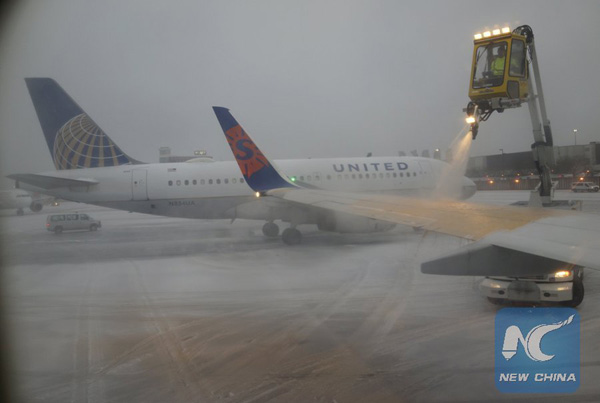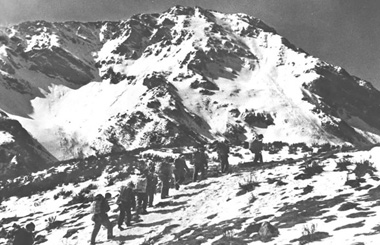New Chinese study helps explain dangerous ice buildup on planes
Updated: 2016-06-22 09:23
(Xinhua)
|
||||||||
 |
|
A Sun Country Airlines plane's wing is de-iced as a United Airlines plane waits at the de-icing station during a snowstorm at Logan International Airport in Boston, Massachusetts, United States December 29, 2015. Picture taken through a window. [Photo/Agencies] |
WASHINGTON - Ice building up on the wings and tail of an aircraft flying during freezing rain is a major concern that could lead to high-speed crashes, and a new Chinese study published Tuesday may help explain why such a dangerous phenomenon occurs.
A well-known culprit involved is the so-called supercooled large droplets (SLD) whose maximum diameter is greater than 1,000 micrometers.
So concerned about SLD are safety officials that on Nov 4, 2014, the US Federal Aviation Administration (FAA) enacted a new rule regulating standards in ice buildup conditions created by the presence of SLD.
Yet, despite the known dangers of SLD, significant knowledge gaps remained.
Now, a research team from Shanghai Jiao Tong University conducted an investigation that pointed to a different icing mechanism at work than previously identified.
Led by Professor Hong Liu, the team worked in a closed-circuit wind tunnel, using a self-designed supercooled droplet generator, and a high-speed visualization system to study abnormal ice buildup on planes.
"The thermodynamic effect during the supercooled large droplet impact process has not received sufficient attention. We set out to fill certain knowledge gaps," explained Liu, whose paper was published in the US journal Physics of Fluids.
"The most critical significance of our model is that it reflects the heat transfer quantity generated from the impact thermodynamics. Nowadays, understanding the mechanism of SLD icing has become a significant goal for researchers concerned with air travel safety, so that is our goal in building and testing the most robust model to date."
Test conditions of the so-called Shanghai Icing Wind Tunnel reproduced the meteorological conditions that might be encountered in flight, as well as realistic variable droplet velocities and temperatures.
By reproducing the impingement phenomenon in the lab, they observed rapid-freezing characteristics in droplets that had diameters of 400, 800 and 1300 micrometers.
The results may be used to more closely characterize meteorological conditions to help pilots safely manage flights that encounter freezing rain and SLD-forming conditions, they said.
"Our results indicate that the drop size is a critical factor influencing the super-cooled heat exchange and effective heat transfer duration between the film/substrate interface," Liu said.
"Our detailed experimental results indeed support the safety rationale behind the rule that the FAA recently adopted."
Next, the team will continue to validate and refine their model through SLD icing simulations in the hope of helping improve air travel safety, particularly in icy conditions.
- Airbus presents 3-D-printed mini aircraft
- AVIC buys British aircraft cabin interior supplier
- Deliveries of huge aircraft expected soon
- Chinese firm acquires Britain-based aircraft cabin interior supplier
- Commercial aircraft company lands contract with Boeing
- Textron says freight aircraft demand is really taking off
- British MPs pay tribute to murdered MP Jo Cox
- DPRK deploys Musudan ballistic missile in east coast
- American singer wants to perform concert in Cuba: media
- Rio government denounced for extravagant spending during crisis
- Planned Obama, Dalai Lama meeting protested
- Gravitational waves detected for second time: scientists

 Croatia rally to stun Spain 2-1 to top Euro 2016 Group D
Croatia rally to stun Spain 2-1 to top Euro 2016 Group D
 Top 10 overseas M&As of Chinese auto companies
Top 10 overseas M&As of Chinese auto companies
 Now and then: Famous venues of the Long March
Now and then: Famous venues of the Long March
 Things you may not know about Summer Solstice
Things you may not know about Summer Solstice
 First lady visits Fryderyk Chopin Museum in Poland
First lady visits Fryderyk Chopin Museum in Poland
 Chinese factories score a goal with Euro 2016
Chinese factories score a goal with Euro 2016
 Euro rookie Welsh makes history to enter knock-out stage
Euro rookie Welsh makes history to enter knock-out stage
 Cavs stun Warriors in Game 7 thriller, LeBron MVP
Cavs stun Warriors in Game 7 thriller, LeBron MVP
Most Viewed
Editor's Picks

|

|

|

|

|

|
Today's Top News
Abe's blame game reveals his policies failing to get results
Ending wildlife trafficking must be policy priority in Asia
Effects of supply-side reform take time to be seen
Chinese State Councilor Yang Jiechi to meet Kerry
Chinese stocks surge on back of MSCI rumors
Liang avoids jail in shooting death
China's finance minister addresses ratings downgrade
Duke alumni visit Chinese Embassy
US Weekly

|

|







